Paragliding
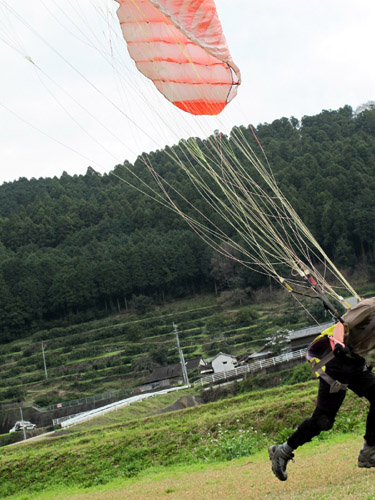
By popular demand, here is the English version, more or less, of our previous entry.

Last month we began a new sport: Paragliding. It’s been a dream since a very long time ago. There is a place called Mt. Kotohira on the outskirts Omura City in Nagasaki that we pass by on our way to rock climbing, where we had often seen gliders floating around. Several years ago we met one of the paragliding club members, Mr. Y. He is 73 years old, has completed nearly 1500 flights, and enjoys a vigor and health that many people half his age could be envious of. His friendliness and enthusiasm did much to make us come back and put a serious effort into learning this exciting sport.
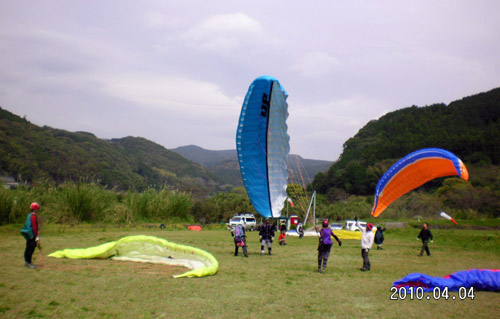
Sunday Flight School at Kotohira LZ.
photo: Kaz
Mr. Y and his cohorts, Mr. K (who happens to be a high-ranking officer in the Japanese Self-Defence Forces) and Mr. N, a talented instructor with 20 years of experience, introduced us to a new world by letting us play with the equipment in the safety of the Kotohira Landing Zone (LZ). The paraglider is composed entirely of cloth and rope; its main part is an elegantly shaped canopy with a span of about 10 meters. The canopy cloth is similar to, but lighter than, tent fly cloth. It is composed of a number of interconnected cells, most of which also have air intakes at the leading edge of the wing. The surprisingly thin ropes (strings really) have an internal core of Dyneema, a fiber that is 40 times stronger than steel by weight. A few small metal pieces and some nylon webbing at the places where the glider attaches to the harness complete the setup. Although put together only with a sewing machine, each glider is a masterpiece of engineering and workmanship, designed and crafted with millimeter precision throughout. Weighing in at only a few kilograms, this amazing aircraft folds into a medium-sized backpack in a matter of minutes. But because it has no internal frame, it must rely on air pressure to inflate and keep its shape. This pressure cannot develop without speed relative to the air, so the first step before flying is to raise and inflate the canopy over one’s head and into the wind. This is much more easily said (and watched) than done: the canopy is fickle, bein g very sensitive to deviations in control symmetry, not to mention the vicissitudes of the wind. In spite of hours of earnest practice, we were not able to raise the glider with any consistency on our first day. Purely by luck, Leanne’s canopy did come up straight a few times. Pushed heartily from behind by N-sensei, she even rose about 60cm into the air, much to her surprise.

The suspension lines of a paraglider are coded by color for ease of recognition during maneuvers.
Returning home after that first day, we thought about the causes of our lack of success. The glider’s motion was too subtle and fast to think about; successful control must be reflexive. One day of practice helped us understand the glider; now it was time to develop the correct reflexes through image training. We spent a number of afternoons running around various parks wearing our climbing harnesses, suspending ourselves in various ways with carabiners and slings, simulating the necessary body English. We even used a bamboo pole to mimic the movements of the suspension in two dimensions. To avoid raising public concern about our mental health, we did these exercises mostly in disused recreational areas, of which, sad to say, there are plenty around here. Rick even applied his programming skills and built a simple computer simulation where one tries to control a graphic resembling the canopy in shape and behavior.
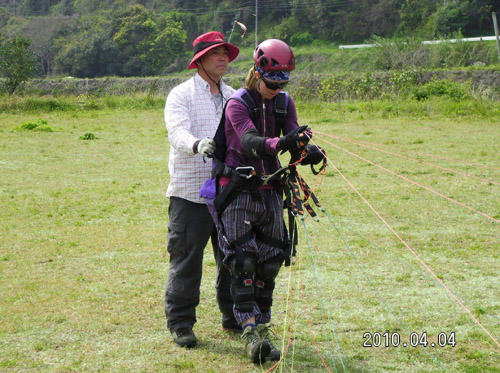
O-sensei, chief instructor and president of the club, makes sure Leanne is perfectly aligned for a practice launch.
photo: Kaz
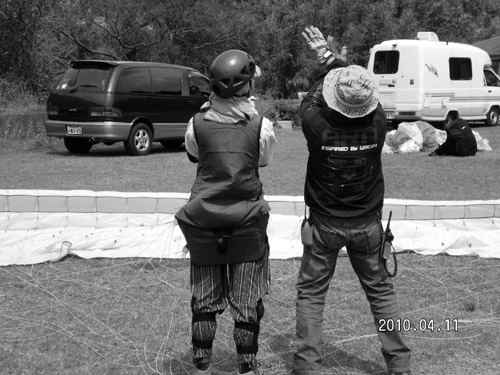
Leanne gets pointers on launching technique from N-Sensei.
photo: Kaz
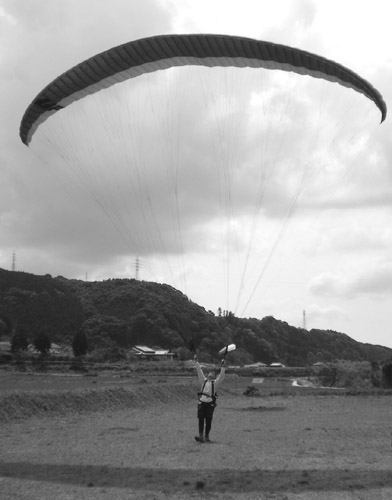
An interesting way to practice is to hold the risers in hand rather than attaching them to the harness. Brakes cannot be used, so the only control is the differential pull on the risers and body positioning. You get an appreciation of the effect weigh-shifting has on the glider. You also really feel the lift the glider is generating as it stretches your arms - and it's a great feeling!
photo: Kaz
All this image training was designed to overcome a particular reflexive problem we had identified. Consider the control of vehicles we are used to (cars, bicycles, kayaks). When the vehicle spontaneously goes in a direction we do not want it to, we apply a certain amount of force in the opposite direction: turning the steering wheel, handlebar, or pushing with the paddle to bring things back in line. But a glider will not react favorably to such control inputs. This is because of two factors: its response is somewhat delayed, and it needs to bank to turn. Fighting with a device that is powerful enough to easily lift you off the ground is obviously not going to yield success: the harder you pull, the harder the glider pulls back, until it (and possibly you also) comes crashing down to the ground. So when it deviates from the desired course, at first one has to run after the glider, overshoot it to give it the necessary bank in the opposite direction, all the while controlling it with the brake toggle in the direction of the desired turn. All this is incredibly counterintuitive: feeling the glider pull to the side, we ran in the wrong direction and/or pulled the wrong toggle virtually every time, with predictable results. Our exercises and computer simulation were designed to reprogram our reflexes, and to this end they were eventually successful.
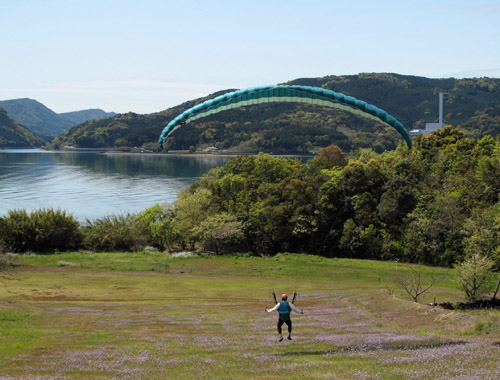
Getting a tiny bit of air at a gentle slope we recently discovered at an abandoned park. This is a very safe and realistic way to practice launches.


1 Comments:
Hi. I was so amazed to see your enthusiasm for paragliding. Yes, practice makes perfect. Enjoy training on the ground, and soon you will find yourselves soaring in the air like birds!!
By Kaz, at 10:26 pm
Kaz, at 10:26 pm
Post a Comment
<< Home